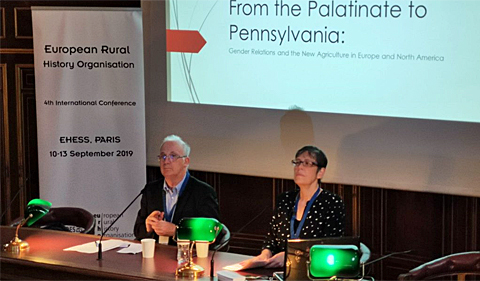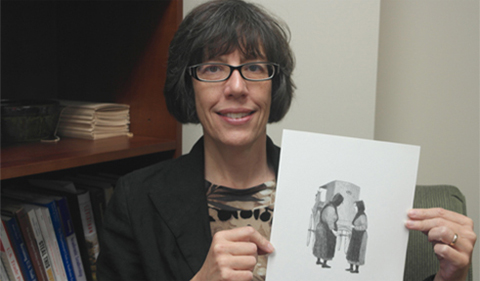Dr. Katherine Jellison, Professor and Chair History at Ohio University, gave the keynote lecture at the 2019 international conference of the European Rural History Organisation.
Held Sept. 10-13 in Paris at the EHESS (School of Advanced Studies in the Social Sciences), the conference served as a major intellectual and academic exchange for European-based scholars working on the rural history of different parts of the world.
Jellison was invited to keynote the conference on the basis of her own research and publication record on U.S. rural history. She is also past president of the Agricultural History Society and former co-chairperson of the Rural Women’s Studies Association.
Titled “From the Palatinate to Pennsylvania: Gender Relations and the New Agriculture in Europe and North America,” Jellison’s keynote lecture explored how Amish households in late 19th- and early 20th-century Lancaster County, Penn., maintained particular configurations of gender roles in family farming that date back to their early modern European origins while at the same time challenged those prescribed by 19th-century European and American agricultural experts.
The full abstract for keynote lecture read as follows:
The New Agriculture that developed in West Central Europe during the Early Modern period included subsistence farming with some market participation, maintenance of soil fertility through the planting of legumes and the application of manure, crop diversification, and keeping large numbers of animals. It also rested on the concept of patriarchal authority over the household labor force. Within that patriarchal structure, however, existed a system of “mutuality” that emphasized shared responsibilities and flexible labor roles. In the Palatinate, Alsace, Baden, and other areas where the New Agriculture developed, the agricultural household emerged as both hierarchical and team-based. The male head of household held ultimate authority, but he and his wife – along with their children and servants – recognized that the household’s survival relied on the interdependence of male and female labor. Nomenclature among German-speaking agriculturalists of the 16th, 17th, and 18th centuries reflected the economic interdependence of male and female household heads, with the man designated as Hausvater (“father of the household”) and the woman as Hausmutter (“mother of the household”). Only in the 19th century did terms reflecting the bourgeois notion of separate spheres become common in the German-speaking countryside, with Landwirt (farmer) and Hausfrau (housewife) coming into daily usage.
In contemporary Lancaster County, Pennsylvania, North American descendants of one group of Early Modern agriculturalists – the Old Order Amish – seemingly represent a direct link to the European past. Rejecting the separate spheres model that 19th-century European and American agricultural experts prescribed, the Amish retained a system of labor-intensive family farming that required mutuality and the crossing of strict gender-role boundaries. Evidence from an extensive study of Lancaster County Amish households in the 1930s demonstrates the degree to which they maintained the practices of their Early Modern ancestors into the modern era.
The Amish are atypical in the extent to which they seemingly continue Early Modern customs in the 21st century, but examination of the agricultural practices that they and other German-speaking settlers brought to colonial North America lends insight into how well the gender customs of Central European agriculture adapted to the American environment.
For more on Jellison’s research and teaching interests, visit her department profile.





















Comments